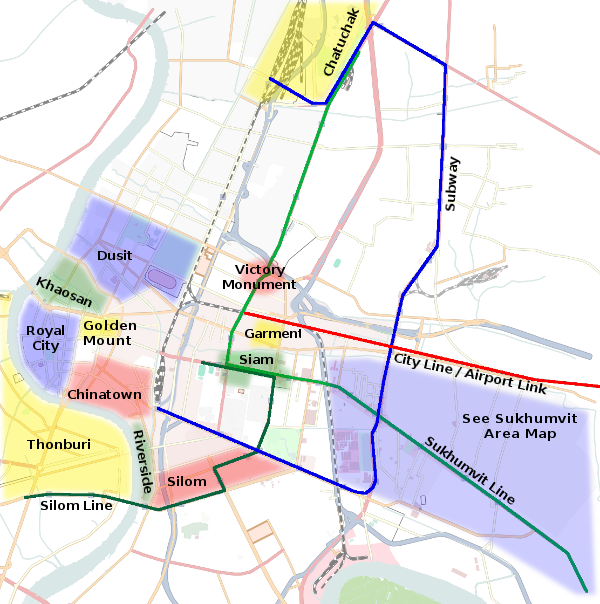Bangkok by District
I like to describe Bangkok as a collection of villages. Indeed, the original royal city of Ratanakosin was once surrounded by a collection of villages which were often identified with specific ethnic groups or crafts, which was often much the same thing. As the city grew, especially in the twentieth century, these villages became absorbed into a greater Bangkok, but many of them still retain signs of their origins. If you've already visited Bangkok once or twice, picking a district to simply wander around in can be a way to discover places you never thought you'd see in the big Mango.
The map below shows some of the many areas of Bangkok that you might want to explore. Some of them you may think you're familiar with, but they can still hold hidden places.

Click on a district for more information, or scroll down for a summary.
Base map image © OpenStreetMap contributors, CC BY-SA
- Ratanakosin Island
- When the city was founded, a canal was dug around its original extents to make a defensible area now referred to as Rattanakosin Island. A wall and fortress defenses originally protected the city. Some of the forts can still be seen today. This old royal precinct is where most of the major sights are, such as the Grand Palace, Wat Po and the National Museum.
- Dusit
- This new royal city was established by King Rama V after a trip to Europe at the end of the 19th century. The district has a distinctly European feel to it.
- Banglampu / Khaosan
- Along the river between the old royal city and the Dusit Palace is the Banglampu area. For many years, this has been the place for budget hotels and guest houses; the district all the backpackers flocked to. In the last few years, it's been 'discovered' by middle-class Thais and the area has been gentrified considerably. The backpackers are still there but are gradually being pushed out.
- Thonburi Side
- Before the founding of Bangkok, King Taksin first established his capital in Thonburi. His palace was in the grounds of Wat Arun. There are still some signs of this early stage of Bangkok's development to be seen, if you know where to look.
- Chinatown
- The Chinese community in Bangkok pre-dates the founding of the Thai capital in the city. Indeed, the land where the grand palace is today was originally a community of Chinese traders. When King Rama I decided to establish the capital on the site of the village of Bangkok, he asked the traders to move. They settled to the east of the new city, along the river.
- Riverside
- The river side area between Chinatown and the Taksin Bridge is where you'll find the vestiges of the first foreign presences in Thailand. The area is home to the French and Portuguese Embassies, the Oriental Hotel and the East Asiatic Company.
- Business District
- The area along Silom Road, and the parallel streets of Sathorn and Suriwong, are the closest thing Bangkok has to a central business district. Here you'll find the offices of many banks as well as some of the country's biggest companies. Smack in the middle of this area is the city's infamous Patpong.
- Siam Square Shopping Area
- While there are shopping opportunities at every turn in Bangkok, the biggest concentration of shops, restaurants and department stores is found around the Siam Square area.
- Chatuchak
- Far removed from the rest of the city is the large weekend market at Chatuchak Park.